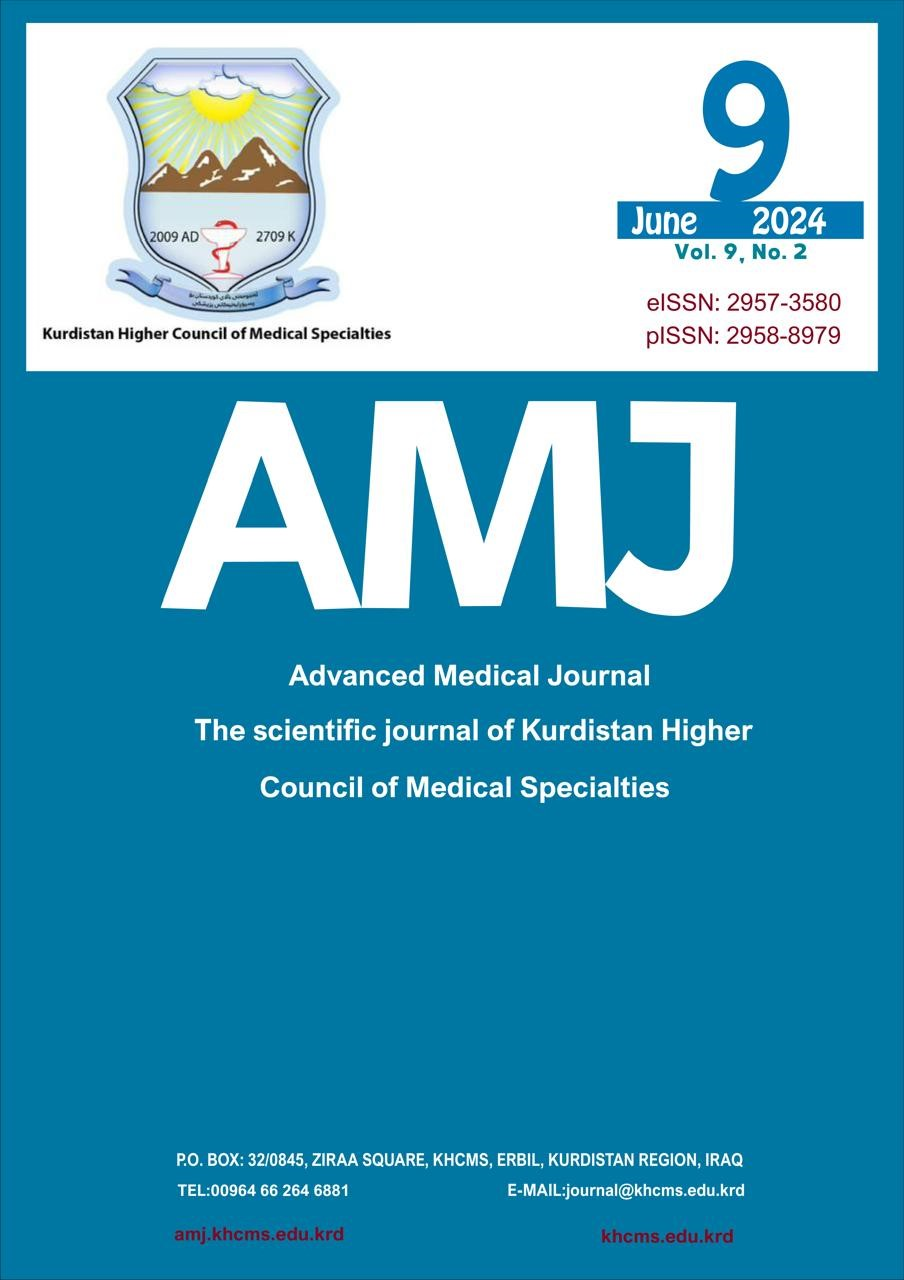Evaluation of serum folic acid level in patients with type 2 diabetes mellitus
DOI:
https://doi.org/10.56056/amj.2024.268Keywords:
Folic acid, Homocysteine, Insulin resistance, Type 2 diabetes mellitusAbstract
Background and objectives: Type-2 diabetes mellitus is a metabolic disorder. Diabetic patients with low folic acid, high homocysteine levels, have a higher chance of developing coronary heart disease based on previous studies. Therefore, this study aimed to investigate the serum levels of folic acid and homocysteine in type-2 diabetes mellitus patients and their association with insulin resistance.
Methods: This cross-sectional study has been conducted on 138 participants from February 2nd 2022 to August 3rd 2022, at Azadi teaching hospital/clinical biochemistry department- Duhok, Kurdistan region, Iraq. The participants were composed of two groups, 70 patients with type-2 diabetes mellitus, and 68 apparently healthy control. Both groups have been investigated for serum folic acid level, serum glucose, serum insulin, serum homocysteine, glycosylated hemoglobin, and Homeostatic Model Assessment for Insulin Resistance.
Results: The mean age for type 2 diabetic patients was (51.24 years) with males predominant (64.29%). Type 2 diabetic patients showed a low level of mean serum folic acid concentrations (2.73 ng/ml) in comparison with healthy subjects (5.91 ng/ml) (p<0.001), and the mean serum homocysteine concentration was (13.493 ?mol/L) among type 2 diabetic patients compared to healthy subjects (10.041 ?mol/L) (p<0.001). Significant correlation was found between serum folic acid and serum homocysteine levels, and glycosylated hemoglobin (p<0.05 and p<0.001, respectively).
Conclusion: Patients with type-2 diabetes mellitus were associated with low mean serum folic acid levels and high mean serum homocysteine levels.
Downloads
References
Abusalah MA, Albaker W, Al-Bsheish M, et al. Prevalence of type 2 diabetes mellitus in the general population of Saudi Arabia, 2000–2020: A systematic review and meta-analysis of observational studies. Saudi J Med and Med Sci. 2023;11(1):1-10.
Wu H, Patterson Ch, Zhang X, et al. "Worldwide estimates of incidence of type 2 diabetes in children and adolescents in 2021. Diabetes Res Clin Pract.2022; 185: 109785:1.
Groop LC. The molecular genetics of non?insulin?dependent diabetes mellitus. J Intern Med. 2001; 241: 95-101. DOI: https://doi.org/10.1046/j.1365-2796.1997.99897000.x
David B. Sacks, M.B, diabetes,In:Carl A.B, David E.B,editors.Tietz Fundamentals of clinical chemistry and molecular dignostics.7th ed.Elsvier 2015.pp 608-609.
Li J, Goh CE, Demmer RT, Whitcomb BW, Du P, Liu Z. Association between serum folate and insulin resistance among US nondiabetic adults. Scientific reports. 2017; 7(1): 1-7. DOI:10.1038/s41598-017-09522-5
Zhang X, Qu YY, Liu L, et el. Homocysteine inhibits pro-insulin receptor cleavage and causes insulin resistance via protein cysteine-homocysteinylation. Cell Reports. 2021;37(2):109821: 7-8.
El-Khodary NM, Dabees H, Werida RH. Folic acid effect on homocysteine, sortilin levels and glycemic control in type 2 diabetes mellitus patients. Nutrition Diabetes. 2022; 12(1):5.?
Vijayakumar A, Kim EK, Kim H, Choi YJ, Huh KB, Chang N. Effects of folic acid supplementation on serum homocysteine levels, lipid profiles, and vascular parameters in post-menopausal Korean women with type 2 diabetes mellitus. Nutr Res Pract. 2017; 11(4): 327-33.? DOI: https://doi.org/10.4162/nrp.2017.11.4.327
Van der Windt M, Schoenmakers S, van Rijn B, et al. Epidemiology and (patho) physiology of folic acid supplement use in obese women before and during pregnancy. Nutrients. 2021;13(2): 331.
Malaguarnera G, Gagliano C, Salomone S,et al. Folate status in type 2 diabetic patients with and without retinopathy. Clin Ophthal. 2015:7;9:1537-42.
Hoogeveen EK, Kostense PJ, Beks PJ et al. Hyperhomocysteinemia is associated with an increased risk of cardiovascular disease, especially in non–insulin-dependent diabetes mellitus: a population-based study. Arterioscler Thromb Vasc Biol. 1998;18(1):133-8.
Soinio M, Marniemi J, Laakso M,et al. Elevated plasma homocysteine level is an independent predictor of coronary heart disease events in patients with type 2 diabetes mellitus. Ann Intern Med. 2004, 20;140(2):97-98.
Flegal KM, Kit BK, Orpana H, Graubard BI. Association of all-cause mortality with overweight and obesity using standard body mass index categories: a systematic review and meta-analysis. Jama. 2013;309(1):2.
So A, Sakaguchi K, Okada Y, et al. Relation between HOMA-IR and insulin sensitivity index determined by hyperinsulinemic-euglycemic clamp analysis during treatment with a sodium-glucose cotransporter 2 inhibitor. Endocr J. 2020;67(5):501-7.
Ebesunun MO, Adetunji KJ, Obajobi EO. Evaluation of essential fatty acids, folic acid and vitamin B12 in type 2 diabetes mellitus. New York Sci J. 2012;5:62.
Wu Z, Zhang H, Li Z, et el. Mutual effect of homocysteine and uric acid on arterial stiffness and cardiovascular risk in the context of predictive, preventive, and personalized medicine. EPMA J. 2022;13(4):581-95.
Gargari BP, Aghamohammadi V, Aliasgharzadeh A. Effect of folic acid supplementation on biochemical indices in overweight and obese men with type 2 diabetes.? Diabetes Res Clin Pract. 2011;94(1):33. DOI: https://doi.org/10.1016/j.diabres.2011.07.003
Asbaghi O, Ashtary-Larky D, Bagheri R,et al. Folic acid supplementation improves glycemic control for diabetes prevention and management: a systematic review and dose-response meta-analysis of randomized controlled trials. Nutrients. 2021;13(7):2355:19-20.
Jankar J, Keerti A. Role of Folic Acid in Type 2 Diabetes. J Pharm Res Int. 2021; 137-43.? DOI: https://doi.org/10.9734/jpri%2F2021%2Fv33i60A34465.
Huang E-J, Kuo W-W, Chen Y-J, Homocysteine and other biochemical parameters in type 2 diabetes mellitus with different diabetic duration or diabetic retinopathy. Clinica Chimica Acta. 2006;366(1-2):293-8 DOI: https://doi.org/10.1016/j.cca.2005.10.025.
Khan A, Rehman S, Ghaffar T. Association of homocysteine with body mass index, blood pressure, HbA1c and duration of diabetes in type 2 diabetics. Pak J Med. Sci. 2018;34(6):1483-7.
Li Z, Gueant-Rodriguez RM, Quilliot D. Folate and vitamin B12 status is associated with insulin resistance and metabolic syndrome in morbid obesity. Clin Nutr. 2018;37(5):1700-6. DOI: https://doi.org/10.1016/j.clnu.2017.07.008
Solini A, Santini E, Ferrannini E. Effect of short-term folic acid supplementation on insulin sensitivity and inflammatory markers in overweight subjects. Int J Obes (Lond). 2006 ;30(8):1197-202.
El-Khodary NM, Dabees H, Werida RH. Folic acid effect on homocysteine, sortilin levels and glycemic control in type 2 diabetes mellitus patients. Nutr Diabetes. 2022;12(1): 33.
Sianipar IR, Ujianti I, Yolanda S, Murthi AK, Amani P, Santoso DI. Developing vitamin B12 deficient rat model based on duration of restriction diet: Assessment of plasma vitamin B12, homocysteine (Hcy), and blood glucose levels. AIP Publishing LLC. In AIP Conference Proceedings 2019:2092(1): id. 020004.
Najib S, Sanchez-Margalet V. Homocysteine thiolactone inhibits insulin signaling, and glutathione has a protective effect. J Mol Endocrinol. 2001;27(1):85-91.
Atabek ME, Ba?c? Z, Pirgon Ö, et al. Plasma total homocysteine levels in childhood obesity. Turk J Endocrinol Metab. 2004;3: 107-11..
Mlodzik-Czyzewska MA, Malinowska AM, Chmurzynska A. Low folate intake and serum levels are associated with higher body mass index and abdominal fat accumulation: a case control study. J Nutrl. 2020;19(1):53.
McNaughton SA, Mishra GD, Stephen AM, et el. Dietary patterns throughout adult life are associated with body mass index, waist circumference, blood pressure, and red cell folate. J Nutr. 2007;137(1):101-2.
Downloads
Published
How to Cite
Issue
Section
License
Copyright (c) 2024 Viyan Mahmood Ali, Sherwan Ferman Salih, Dhia Mustafa Sulaiman

This work is licensed under a Creative Commons Attribution-NonCommercial-ShareAlike 4.0 International License.
The copyright on any article published in AMJ (The Scientific Journal of Kurdistan Higher Council of Medical Specialties )is retained by the author(s) in agreement with the Creative Commons Attribution Non-Commercial ShareAlike License (CC BY-NC-SA 4.0)









